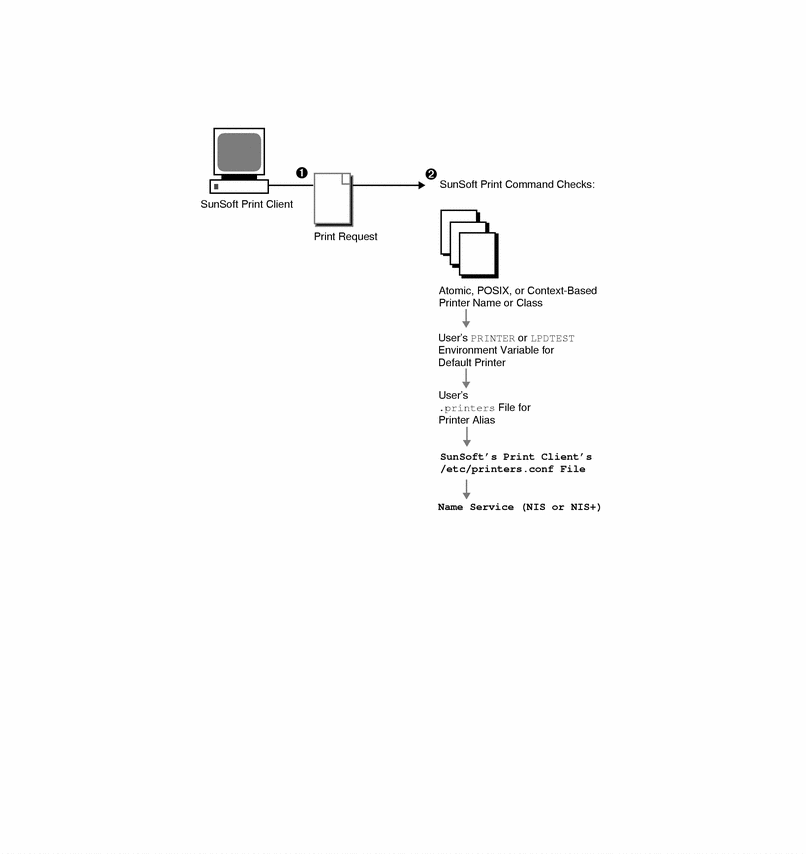The Advantages of SunSoft Print Client Commands in Locating Printers
The print configuration resources are a key component of the SunSoft Print Client software: They increase printing efficiency because of the method they use to locate printer information. To illustrate the advantages, the next sections compare the Solaris 2.x and SunSoft methods to locate printers.
How the Solaris 2.x Print Software Locates Printers
As shown in Figure 1-4, the print command in the Solaris 2.x (SunOS 5.x) operating environment uses only local resources to locate printers and printer configuration information.
Figure 1-4 How the Solaris 2.x Print Software Locates Printers

-
A user submits a print request from an SVR4 print client by using the lp or lpr command. The user can specify a destination printer name or printer class with either the lp -d or lpr -P command and option, as shown in these examples:
% lp -d neptune
% lpr -P pluto
-
The print command locates a printer and printer configuration information.
-
It checks to see if the user specified a destination printer name or printer class when submitting the print request.
-
If the user didn't specify a printer name or class, the software checks the SVR4 print client's /etc/lp/default file for a default printer name.
-
When the print client software finds the printer name or class, or has located a default printer, it checks the SVR4 print client's /etc/lp/printers directory for configuration information on the printer or printer class.
-
There are two main disadvantages in the Solaris 2.x method to locate printers:
-
There is no central file for storing printer information. If you want to add, modify, or delete a printer for all print clients on the network, you have to change each client's printer configuration files individually.
-
You cannot make a master /etc/lp/printers directory with all printers on the network and copy it to print clients.
How the SunSoft Print Client Software Locates Printers
As shown in Figure 1-5, the SunSoft print client commands use more options to locate printers and printer configuration information.
Figure 1-5 How the SunSoft Print Client Software Locates Printers

-
A user submits a print request from a SunSoft print client by using the lp or lpr command. The user can specify a destination printer name or class in any of three styles:
-
Atomic style, which is the print command and option followed by the printer name or class, as shown in the next example.
% lp -d neptune
-
POSIX style, which is the print command and option followed by server:printer, as shown in the following example.
% lpr -P galaxy:neptune
-
Context-based style, as defined in the Federated Naming Service Programming Guide in the Solaris 2.5 Software Developer AnswerBook, shown in the next example.
% lp -d thisorgunit/service/printer/printer-name
-
-
The print command locates a printer and printer configuration information as follows:
-
It checks to see if the user specified a destination printer name or printer class in one of the three valid styles.
-
If the user didn't specify a printer name or class in a valid style, the command checks the user's PRINTER or LPDEST environment variable for a default printer name.
-
If neither environment variable for the default printer is defined, the command checks the .printers file in the user's home directory for the _default printer alias.
-
If the command does not find a _default printer alias in the .printers file, it then checks the SunSoft print client's /etc/printers.conf file for configuration information.
-
If the printer is not found in the /etc/printers.conf file, the command checks the name service (NIS or NIS+), if any.
-
These are the advantages of the SunSoft method to locate printers:
-
You can use a name service (NIS or NIS+) to store printer information in one central location. This is the single most important feature of the SunSoft Print Client software. If you want to add a printer and make it available to all SunSoft print clients on the network, all you have to do is enter the printer information in the name service. The same principle applies to modifying and deleting printers. The printer information in the name service is available to all SunSoft print clients.
-
Users can manipulate their .printers file to customize printer information. Even though SunSoft print clients know about the printers that are listed in the name service, you can customize the clients' printer configuration files to use printer aliases and to find only certain printers when canceling print requests or getting status information.
-
If you don't use a name service, you can still decrease the amount of time it takes to set up and administer printing by creating a master of the /etc/printers.conf file with all printers on the network and copying that file to SunSoft print clients. For further information about using the /etc/printers.conf file, see Chapter 2, Updating SunSoft Print Clients to Access Existing Printers.
- © 2010, Oracle Corporation and/or its affiliates
